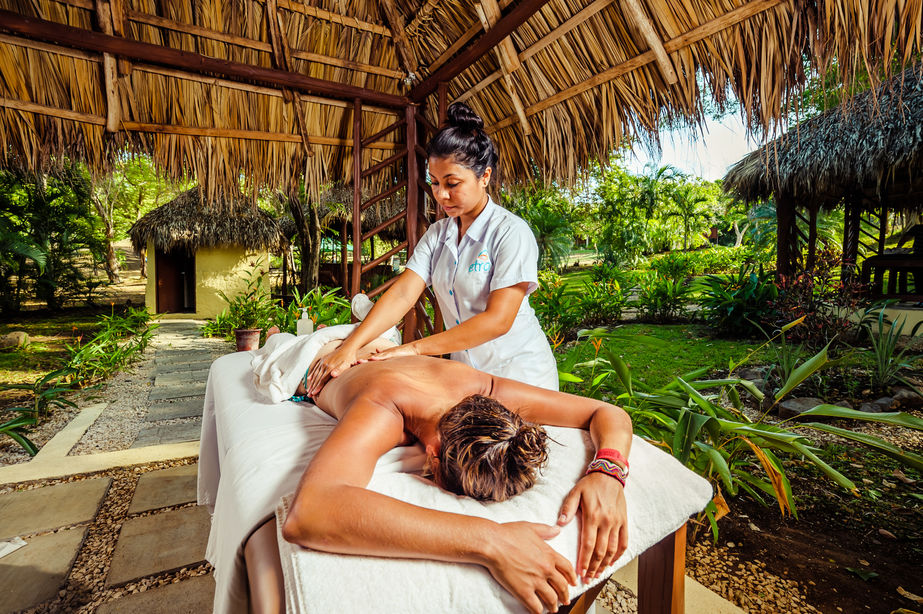
Warm Waters and Natural Attractions
In Costa Rica's favorite wellness destination, nature supplies the prime ingredients in the form of warm, mineral-laden waters and lush tropical foliage. Resorts capitalize on the setting, creating oases of relaxation near flowing hot springs. On-site spas tucked into garden settings deliver a variety of both traditional and innovative treatments. And before or after each session, there are hot soaks, cool plunges and invigorating cascades just a short stroll away. To complement the journey to wellness, chefs create savory and nourishing offerings, and guides stand ready to lead walks that showcase the natural beauty of the land or organize an active adventure.
Highlights
- Best for: All travellers from budget to luxury with a love of nature and adventure
- Best season to visit: Year Round, drier November - May
- Weather: There is minimal seasonal variation in air temperatures, with highs reaching near 90 and lows touching 70 at night. The wet season runs from May through November, drier months from December to April bring lower humidity
Things to Do
- Cultural Activities
- Diving
- Hiking
- Offroading
- Paddle Sports
- Ziplining
Costa Rica Information
Spa and Wellness in Costa Rica Overview
Many of Costa Rica's premier spas are locate near the town of la Fortuna, which is overlooked by the mile-high slopes of Arenal Volcano. A number of springs in the area vent thermally-heated mineral waters that are prized for their relaxing and revitalizing properties. The area's lush landscapes and mild climate create additional attractions for visitors.
Spa and Wellness in Costa Rica Tips
Relaxation isn't the only reason to visit the spas of La Fortuna. The area offers a wide range of activities, from sky trams, butterfly farms and nature trails set high in the treetops on suspension bridges to active sports such as kayaking, mountain biking, horseback rides and cave tours.
Best Places for Spa and Wellness in Costa Rica
The spa at the Arenal Springs Resort is set in tropical gardens that frame dramatic views of a volcanic peak. The natural hot springs of Tabacon are heated by volcanic forces and flow from the ground to form cascades and soaking pools. Bathing rituals at the Neidin spa at Arenal Kioro include energizing chocolate soaks and rejuvenating wine and honey baths.
Passport and/or Visa Requirements
A valid passport is required for entry that must be valid for length of stay. No visa is required for stays less than 90 days. The passport must have at least one blank page for the Costa Rica entry stamp. There is a departure tax of approximately $29 U.S. which should be included in your international ticket. Check the entry/exit requirements here.
Immunizations
There are no immunizations required for entry into Costa Rica, although you should check with your doctor and with the Centers for Disease Control and Prevention for other recommendations.
Culture and Customs
Costa Rica is known as the safest and most prosperous country in Central America. It is home to a large community of North American ex-pats, but also retains its distinctly Latin culture, which includes a relaxed attitude to schedules that is known as “Tico time.” Laid back is not the same as uncaring, however, and Costa Ricans are known for taking pride in their appearances and their work. A well-developed road system connects major destinations, but much of the country's central highlands remain wild and protected within national parks. Within a day's drive of beach resorts at Guanacaste lie the slopes of Arenal Volcano, the Monteverde Cloud Forest and Palo Verde National Park. Costa Rica is the eco-adventure capital of the Caribbean. Surfers come from around the world to ride famous breaks from Witch's Rock to Pavones. Coastal lodges are filled with fishermen seeking light tackle challenges with roosterfish or tug of war with a marlin. Forests draw birders, hikers and naturalists, and there are more than a dozen rivers offering whitewater rafting thrills. More relaxing experiences await at hot springs, where spa treatments and soaks in mineral-rich volcanic water provide a soothing end to an active day.
Electricity, Phone and Internet Access
The standard in Costa Rica is the same as in the United States: 110 volts AC (60 cycles). Some electric outlets only have 2 prong sockets, so an adapter may be needed for 3 prong plugs.
Costa Rica has an excellent phone system, and the country code for dialing is 506. Check with your cell phone provider for international data and voice plans and costs.
Many resorts and restaurants offer WiFi.
Water Quality
Although the water in Costa Rica is generally safe to drink, water quality varies in some cities. It would be best to use bottled water and avoid ice.
Language & Currency
Spanish is the official language of Costa Rica, but English is widely spoken. The Costa Rican currency is called the “colon”. Check the current exchange rate here. Many businesses will accept U.S. Dollars and major credit cards are widely accepted.
Time
Costa Rica is on Central Standard Time, 6 hours behind Greenwich Mean Time (-6 GMT). Costa Rica does not use daylight saving time, so the time difference is an additional hour April through October.
Location, Size and Population
Costa Rica is located in Central America, bordering both the Caribbean Sea and the North Pacific Ocean, between Nicaragua (to the north) and Panama (to the south). Costa Rica encompasses a total of 19,700 square miles (51,100 square kilometers).
The population of Costa Rica is 4.9 Million (2015) with approximately 350,000 living in the province of Guanacaste.